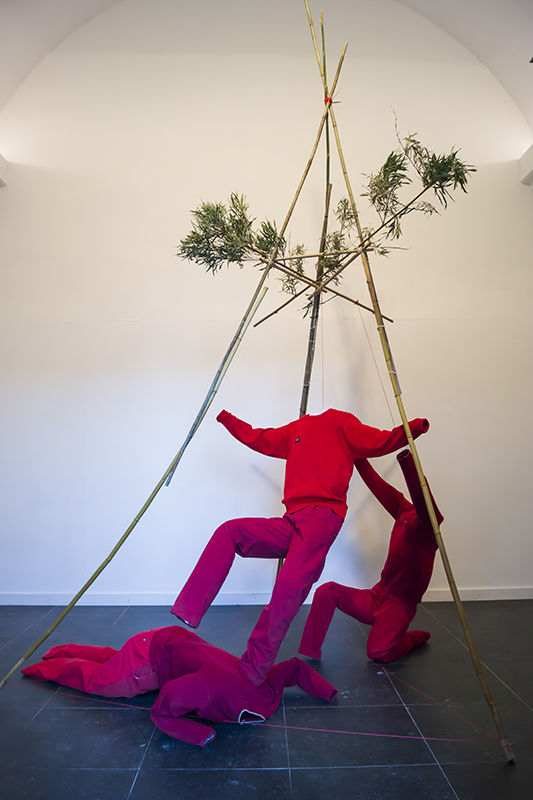Position IV: Transition in Public View
Position IV was a site specific sculptural installation of red clothing that unfolded over three months in a former Catholic mission chapel—now an art space visible day and night, inherently linked to the public realm.
It was a temporary, site-specific installation composed of red clothing, created for a former Catholic mission chapel in Heythuysen—now repurposed as an art space that remains visible day and night. Its continuous visibility made the work part of the public realm throughout its existence.
Though ephemeral, Position IV evoked the lasting weight of symbolism. Its constellation of sculptural forms referenced traditional Christian composition, while inviting reinterpretation through diverse social and cultural lenses. Themes such as power dynamics, exploitation, consumer excess, and environmental degradation pulsed beneath the surface.
Position IV rejected the traditional static nature of sculpture. This approach aligns with my overarching practice, where movement and change—both physical and conceptual—shape how meaning and interpretation evolve over time.
Position IV
Unfolding over the course of a three-month exhibition, the installation developed in distinct stages. These evolving formations disrupted the notion of sculpture as a static medium, instead embracing impermanence and continual transformation. This temporal approach reflects my ongoing interest in change as an essential condition—not only of materials and space, but of meaning itself.
With each new phase, the installation offered a fresh moment of visual and emotional intensity—like a film stretched across time, where every frame stood still for four weeks. These moments formed a gradual sequence—each distinct, yet part of a larger movement unfolding over time, a slow choreography of shifting presence and meaning, leaving behind a memory trail that was as much part of the work as its physical form.
Position IV | first stage
The first stage revealed a solitary figure—kneeling or crawling—uncertain whether searching, struggling, or rising.
Position IV | second stage
Over time, a second presence emerged, shifting the dynamic with force—its movement assertive, imposing upon the first, creating an undeniable tension within the space.
Position IV | third stage
The addition of a third figure altered the composition, positioned to support the second figure’s movement and presence, reinforcing its action. The appearance of a third figure introduced group dynamics, shifting the scene from individual confrontation to a broader structural tension. While the positioning of the sculptures remained unchanged, the evolving relationships altered perception, reframing both the artwork and the site itself. Each stage revealed a distinct perspective, demonstrating how meaning unfolds through deliberate shifts in form, space, and composition. The chapel, rich with its own histories and associations, became integral to this transformation—its significance interacting with the evolving presence of the work, while remaining open to different individual experiences.
This art installation existed within a space that carried layers of historical and cultural significance, allowing these associations to be part of the viewer’s experience. Its visibility in a public-facing art space meant encounters with the work were not uniform, and perception shifted depending on time, context, and perspective. Structured as a series of staged moments, Position IV refused fixity—each phase redefined perception, much like film stills that freeze individual moments while implying movement beyond the frame. By introducing figures gradually, the installation changed not only its internal dynamics but also its relationship with the chapel itself, allowing the space to actively shape meaning rather than serve as a neutral backdrop.
Extending Position into Public Discourse: Social Media as Space for Reflection
During the time the installation was on view, I initiated an additional hashtag project using #Position on social media. This allowed a wide range of messages—each touching on themes relevant to the term—to surface. Together, they formed a contemporary reflection on a highly hierarchical society marked by (gender) inequality. A selection of these posts was compiled into a smartphone-sized video, creating a time-specific document. It could be viewed in dialogue with the sculptural installation or as a standalone piece—an exploration of the term 'position' and its varied social and cultural meanings worldwide. Although the video is no longer available, the hashtag remains active for anyone wishing to discover what #Position continues to represent in the present moment.
Carried into the digital realm, the project extended its conceptual depth. The openness of the hashtag invited ongoing engagement, while anchoring the work within broader social and spatial frameworks. In this way, it continues to live beyond the physical installation—circulating through a digital commons where themes of hierarchy and inequality remain vividly present.
click for other works in the series




